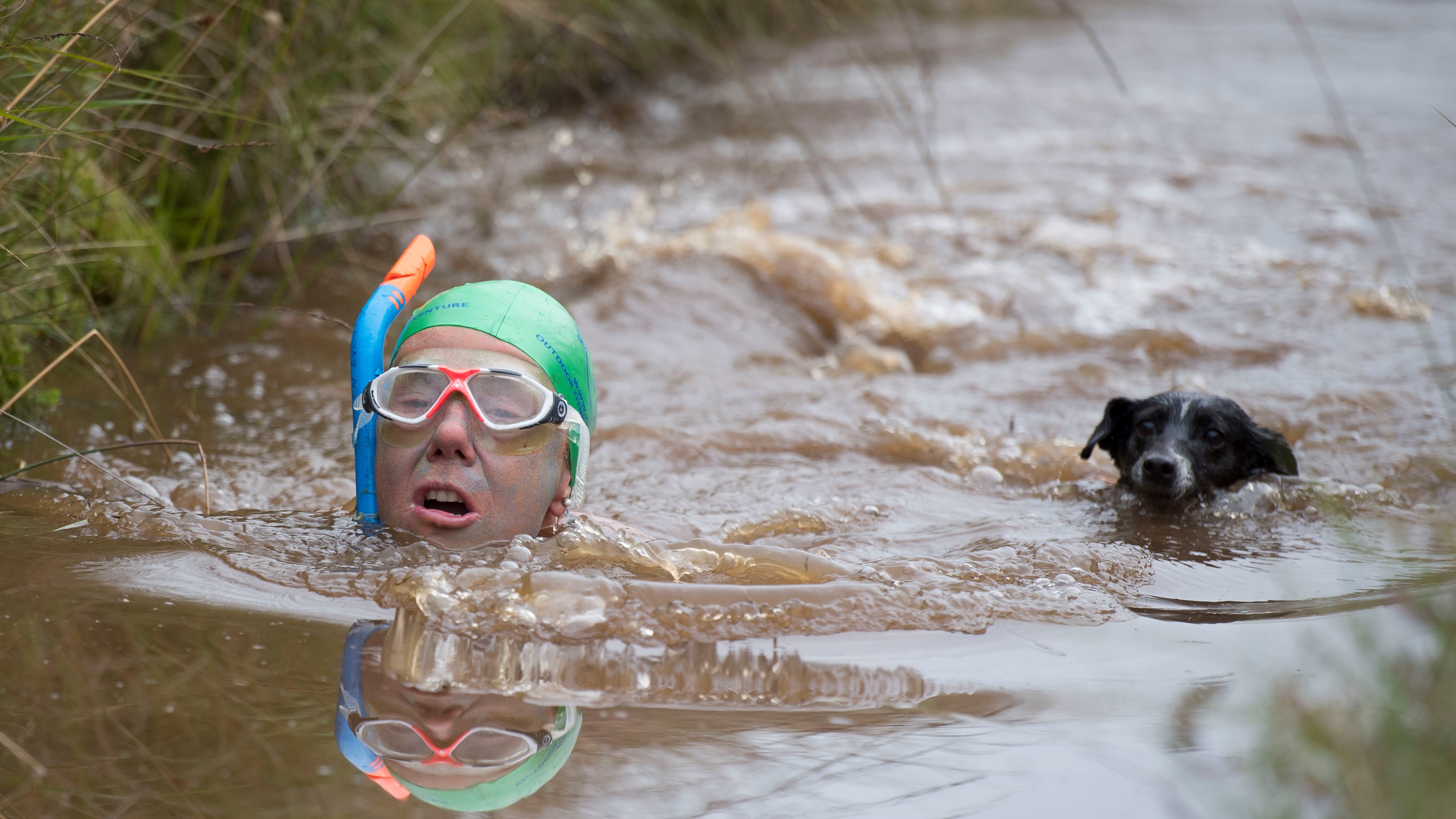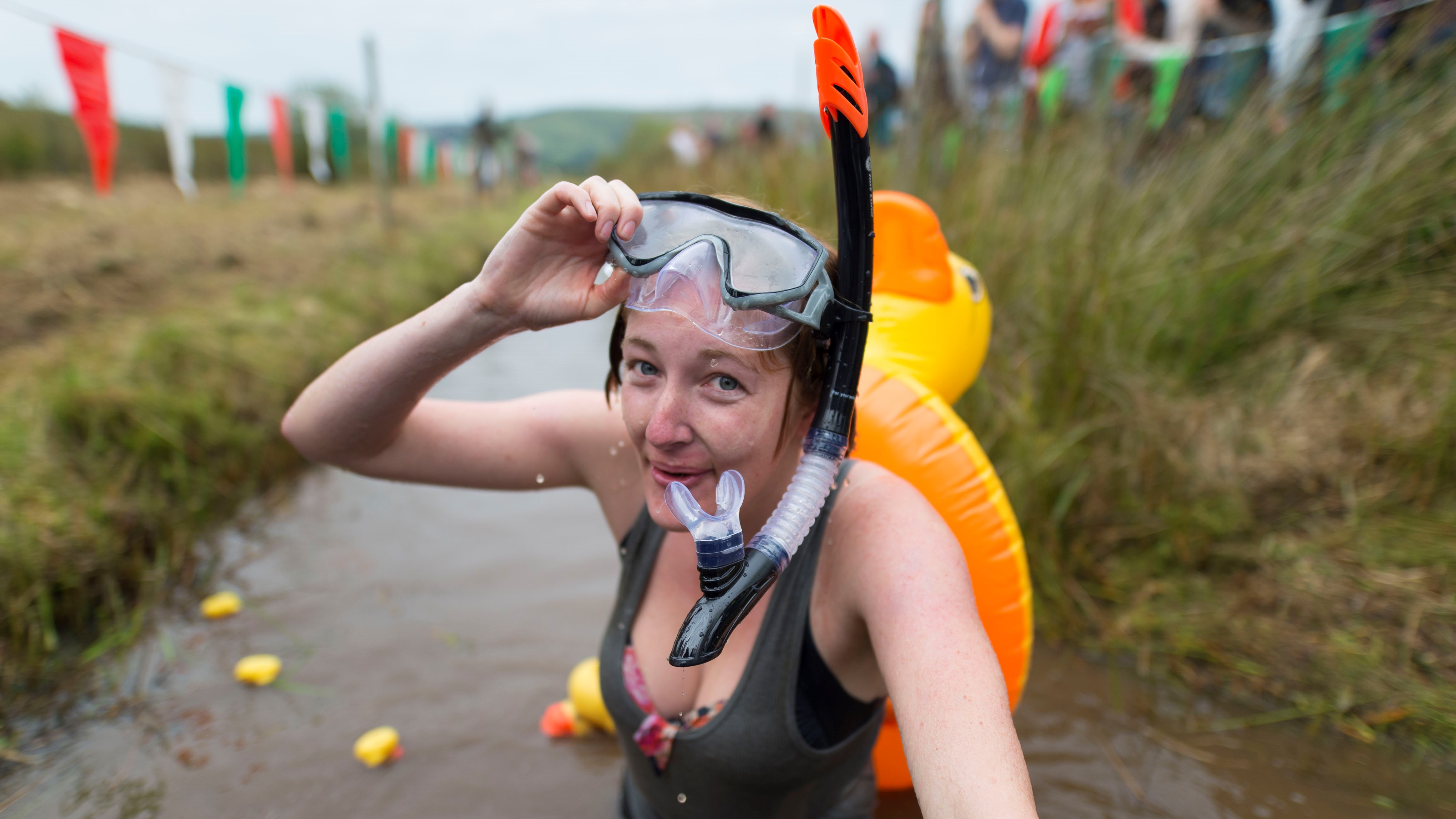Bog snorkelling: the history of this unlikely sport, and why you should give it a try
Bog snorkelling is easily one of the most intriguing outdoor adventures we’ve heard about – do you wear a wetsuit? Dress up as a superhero? We got the answers

Every so often, an outdoor event comes along that is so strange it simply defies all reason. Youngsters chasing a wheel of cheese down a hill in an alarmingly precarious fashion in Gloucester, UK each June. Trail runners leading a donkey carrying precisely 33lb of traditional mining equipment across the Colorado Rockies in an annual burro racing event. Then there’s a Sunday in August where people wearing snorkels and flippers (and often, a superhero costume) descend from the farthest flung corners of the globe onto the smallest town in Wales to compete in the annual World Bog Snorkelling Championships.
Bog snorkelling is easily one of the most intriguing outdoor pursuits we’ve heard about, and obviously as adventure-seekers we wanted to know more. So, we recently grilled Bob Greenough, a resident of Llanwrtyd Wells where the championship takes place on what bog snorkelling is. Greenough is on the committee for Green Events which coordinates the championships and he gave us all the answers, from whether or not you need a wetsuit to the strangest costume he’s seen at the event.
“People come from all over the world specifically to do this event. Which is crazy, really, but they do,” says Greenough, who has never competed in the event himself due to what he calls his “negative buoyancy” condition that resulted in the refund of his swimming lesson tuition money.
“We’ve had people turn up from Australia on a Friday and go home on the Monday just so they can do it. We’ll get Americans, Canadians, Ukrainians and Poles and people from Mali and South Africa. It all adds to the atmosphere because people are walking around with their country flags draped over their shoulders. It’s a great day.”

OK, back up. What is bog snorkelling?
Bog snorkelling is exactly what it sounds like. Rather than an activity that people do after work and on weekends, however, bog snorkelling is an annual event that takes place in Wales (there are also events in Sweden, Australia and Ireland) and involves people donning a snorkel and flippers and snorkelling two lengths of a 60-yard trench that has been dug into a bog. If you don’t know, a bog is a type of freshwater wetland consisting of soft, spongy ground formed by partially decayed plant matter called peat. There are lots of bogs in the UK, and digging a trench in one allows the water to pool deeply enough that you can snorkel through it, at the average pace of about two and a half minutes per 120 yards, according to Greenough.
So, this isn’t the speediest event you’ll ever watch – don’t try to compare it to, say, a 100m freestyle at the Olympics where the winners tend to finish in under 50 seconds. That said, the fastest time on record, so far, was 01:18 set in 2018 by Neil Rutter, which isn’t too shabby. However, while there are some folks who show up to win, there's no way to actually train for this event.
“You do get people who are competitive swimmers, but it doesn’t really help because they can’t use their arms. You can only use your legs, that’s the only power you’ve got. So everyone starts out doing something that they’ve got no hope of practising for. Unless you dig a bog in your back garden, of course,” says Greenough.
All the latest inspiration, tips and guides to help you plan your next Advnture!

Some people take as long as five or six minutes, so the event kicks off at 9 a.m. but doesn’t usually wrap up until almost dinner time, but no matter. The real attraction, for most, is about putting on a show.
“People go through with toilet seats on their backs and mini boats and there’s lots of super heroes,” says Greenough, who recalls that the most unusual costume he’s seen was two women who showed up in a pantomime horse costume.
“We were puzzled because we could figure how the one at the front could breathe but we couldn’t how the one in back could – she must've got the snorkel up the costume somehow. But they incredibly did two lengths.”
So it’s not a fast event, but it’s really, really fun.

Where did bog snorkelling come from?
If you’re harbouring any romantic notion that bog snorkelling is some ancient Welsh ritual, it isn’t. According to Greenough, where bog snorkelling came from all depends how far you want to go back into history. You can start in a pub in Llanwrtyd Wells in 1976, but the whole thing was set into motion decades previously.
Llanwrtyd Wells, in the middle of Wales, has a population of just 850 people and claims to be the smallest town in the whole UK, but in the early 1900s right up to World War II it received thousands of visitors every year who came for the healing properties of the water. Then in 1948, everything changed.
“Along comes the NHS and suddenly everyone can get a pill to make them feel better,” says Greenough. The result was that tourism turned off in the town practically overnight like a proverbial tap, and along with it went the bulk of the economy. Most visitors to Wales now headed to the beautiful coastline or into the mountains of Snowdonia National Park, overlooking the spa town or merely passing through. Back in forgotten Llanwrtyd Wells, the infrastructure for tourism was still very much in place, so by the mid 1970s, the town’s residents saw fit to band together in the local pub to devise some events that would draw people back to the area.

Over time, they came up with Man versus Horse which pits trail running shoes against hooves over rough ground, the Real Ale Wobble mountain biking event and at some point, one member of the committee suggested digging a swimming pool into the bog in his back garden, according to Greenough. At the next meeting, no one had forgotten about it so they dug a 60 yard trench and, deciding that swimming in a bog isn’t particularly possible, came up with the idea of bog snorkelling.
And thus, in the year 1985, the first World Bog Snorkelling Championship took place and has continued every year since, barring the odd pandemic of course, taking place on August bank holiday Sunday. The event has flourished to require a second trench to be dug (it’s a time trial event, so to speak, where one competitor at a time tackles the bog) to accommodate the 180 or so participants who showed up in 2022, and roughly five times as many spectators as entries show up in their waterproof hiking boots to cheer on the competitors.
In fact, it’s grown so much that on the day before the championship, there is now another bog-associated event – a sprint triathlon consisting of 60 yards of bog snorkelling, two miles on a bike and another mile of running. Doesn't sound very far? Remember, none of it won’t be over flat or dry land; it’ll all be on bog land.

What are the rules of bog snorkelling?
The rules of bog snorkelling in Llanwrtyd Wells are, well, clearer than mud anyway. You have to wear a snorkel and flippers (that you bring to the event with you) and to compete, you have to snorkel two lengths, equalling 120 yards (that’s 110m or 360ft). As for technique, you can snorkel with your arms straight ahead of you in a “V” shape or down by your sides, or even try the underwater doggy paddle but that slows you down, according to Greenough. No other swimming strokes are allowed.
Upon entering the competition, you'll receive a full list of rules, but these are some of our favorites:
- Competitors must snorkel 2 lengths of the bog (120 yards in total) and touch the post at both ends. The turn post must be touched above the water level.
- There are no rest times allowed for in the timing.
- A competitor who, at the discretion of the timekeeper, takes too long to complete the first length of 60 yds will be asked to leave the bog by the timekeeper at the end of the first length.
- Fins may be used, but no mono-fins.
- Webbed gloves or similar are not permitted.
- Competitors must swim with their faces in the water, using the snorkel to breathe; occasional 'looks' to correct direction are allowed.
- It will be considered a ‘tie’ if the fastest two snorkelers are within 0.5 seconds of each other. In the event of a tie, we will hold a ‘bog-off’ after the last snorkeler of the day has completed their swim. These 2 (or more) competitors will be asked to complete a timed swim again.
- Fancy dress optional but encouraged!
Whether to wear a wetsuit or not is really up to you. Bog water can be freezing cold, unless it’s really, really hot like it was in 2022. A wetsuit keeps you warm, but also slows you down which a couple from Yorkshire learned a few years back.
“They were very competitive. They both wore wetsuits and the husband beat the wife by a few seconds. The next year, they came back and she didn’t wear a wetsuit and won the whole thing,” recalls Greenough. Winning the whole thing means that she is now listed in the Guinness Book of Records, as could you be too if you want to try snorkelling through cold (unless it’s hot) brown water where you can’t see a thing.

Wait, what lives in a bog?
If you’re wondering if the local bog population is temporarily displaced to allow for you to compete without something brushing up against your leg, the answer is obviously no. Bogs are home to plants, insects, larvae like caterpillars and even amphibians like newts and frogs and you’ll be snorkelling with them, but there’s no need to worry.
“People always say the water’s dirty but there’s living things in there. If we transfer those living things into a sterile swimming pool somewhere with chlorine, they would die. Surely they’re better off in the dirty water?” reasons Greenough, who does reassure us slightly that the water is tested for safety, occasionally.
Of course, if you can’t stomach the thought of that, you can always just head down and spectate without getting wet, though Greenough advises that some spectators do end up taking part once they see how much fun it is, so best to bring a backup pair of flippers then.
“Just come down and have a go. We’ll have a band playing, there’s a bar down there, there’s food, it’s quite a fun day.”
The Rude Health World Bog Snorkelling Championship organised by Green Events takes place on August bank holiday Sunday in Waen Rhydd bog on the outskirts of Llanwrtyd Wells.
- The best water shoes: for all your aquatic activities
Julia Clarke is a staff writer for Advnture.com and the author of the book Restorative Yoga for Beginners. She loves to explore mountains on foot, bike, skis and belay and then recover on the the yoga mat. Julia graduated with a degree in journalism in 2004 and spent eight years working as a radio presenter in Kansas City, Vermont, Boston and New York City before discovering the joys of the Rocky Mountains. She then detoured west to Colorado and enjoyed 11 years teaching yoga in Vail before returning to her hometown of Glasgow, Scotland in 2020 to focus on family and writing.

